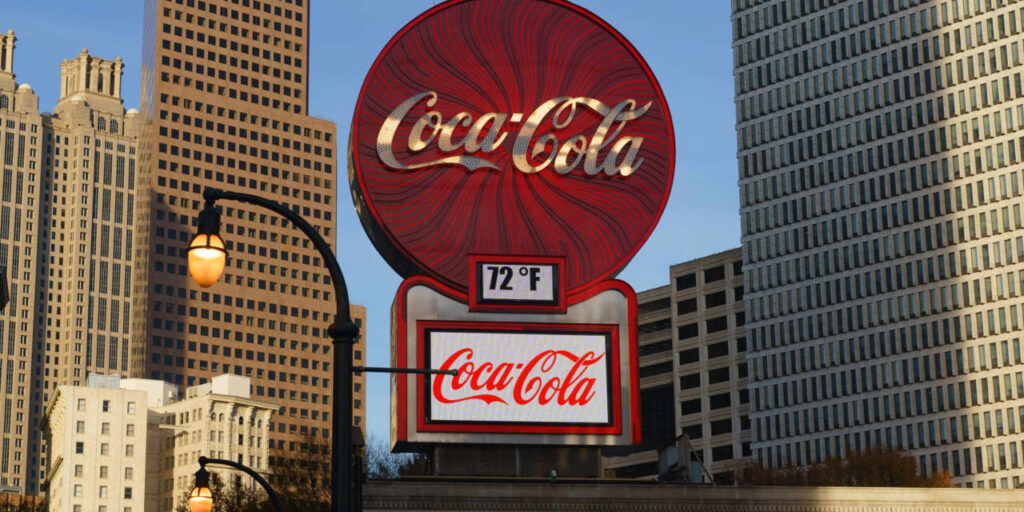Coca-Cola
easily topped third-quarter estimates, assuaging investor concerns that consumer demand for beverages was slowing.
Coca-Cola
posted adjusted earnings of 74 cents a share, higher than estimates of 69 cents.
Revenue grew 8% to $11.95 billion, beating expectations of $11.4 billion. Sales grew 11% when adjusted for currency fluctuations and other accounting measures.
Unit case volume rose 2% during the quarter. The company’s ability to raise prices also helped drive revenue growth. Price/mix, or the change in revenue caused by price changes and the mix of products sold, grew 9% this quarter.
“Overall, our industry remains vibrant and expanding, and we are executing to capture that growth,” said Chairman and CEO James Quincey on a call with investors Tuesday.
The company raised its guidance for the fiscal year even as executives warned some consumers in developed markets were feeling pressured. Coca-Cola expects to deliver full-year organic revenue growth of 10% to 11%, higher than a prior range of 8% to 9%. It also called for comparable earnings per share growth of 7% to 8% up from a previous forecast of 5% to 6%.
Shares gained 3.2% to $55.83 on Tuesday. The stock has declined 12% this year.
Consumer staples have gotten crushed this year. The
Consumer Staples Select Sector SPDR ETF
(XLP) has slumped over 9% this year, compared with a 9.8% gain for the
S&P 500.
Even solid earnings haven’t helped some of the stocks gain ground. Earlier this month, competitor
PepsiCo
(PEP) posted a stronger quarter than expected and raised its fiscal year guidance. While Pepsi shares got a small bump immediately after the company posted earnings Oct. 10, they have since shed 0.4%. Year to date, Pepsi stock is down 11%.
There are several things weighing on the sector. For one, the investment cycle has turned a page. Many investors who piled into consumer staple stocks in 2022 to ride out market volatility have since pulled out, driven by high valuations, rising interest rates, and a broader market rally that has made other sectors look more appealing.
Investors have also been worried that consumer demand will slow as macroeconomic pressures start weighing on their budgets. Coca-Cola’s revenue and volume growth helped assuage those concerns, and the company believes it can keep momentum going into 2024. Executives cautioned, however, that some consumers were starting to feel the impacts of macroeconomic pressures.
“In developed markets, consumer spending in aggregate has held up quite well. However, some consumers feel pressured,” Quincey said. “We’ve seen some shifts to discount channels and switching to private label brands in a few months different categories.”
The slowdown was especially salient across Europe, Quincey added, but consumers in Japan, North America, and Australia have also exhibited similar behaviors. Because of that, the company expects it won’t be able to raise prices as much in coming quarters.
Consumer demand was more mixed in developing and emerging markets, with strength across Latin America, India, and parts of Asia.
In North America, there are added fears that weight loss drugs will negatively affect demand for sugary snacks and drinks. On Tuesday, John Murphy, Coca-Cola’s chief financial officer, said it was an area the company was “very focused on.” He added that 68% of the company’s products have low or no calories and can still cater to shifting consumer preferences.
“We are well positioned to provide choice and to provide options for people with respective motivations and needs,” he said.
Pepsi said earlier in October the impact has been negligible so far.
A more pressing issue for Coca-Cola this year is foreign exchange rates, given the dollar has been stronger than many foreign currencies in the past few months. In the third quarter, currency curbed earnings per share growth by 4%. The company expects exchange rates to curtail comparable earnings per share growth by 6% for the full year, and said it expects its currency challenges to continue into 2024.
“While KO’s EPS power has been restrained by a strong dollar, underlying fundamentals have been as strong as we can remember,” wrote Nik Modi, analyst at RBC Capital Markets, in a client note Tuesday. “We believe the company’s latest restructuring and organizational design changes will facilitate better allocation of resources, which should ultimately lead to better share gains and white space expansion.”
Modi has an Outperform rating and a $70 price target on the shares.
Write to Sabrina Escobar at [email protected]
Read the full article here



